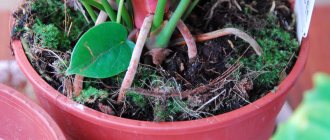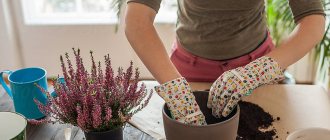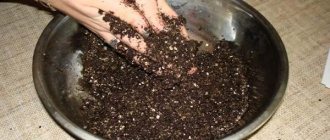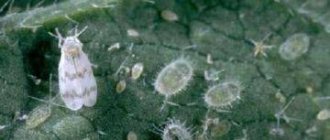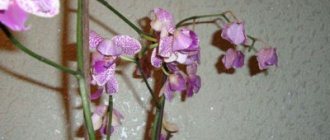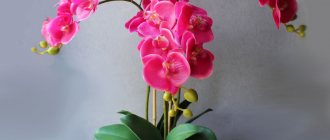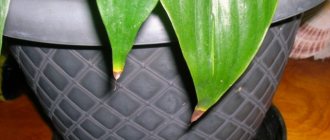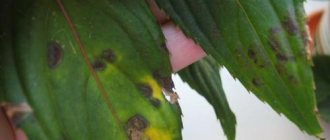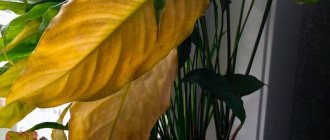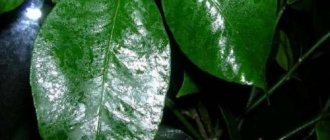Experienced gardeners are able to grow good crops in any environment and soil. The most favorable are considered: clayey, peat and sandy. The first two options can be created artificially, but the second is natural and not all garden plots are used for growing crops. Moreover, many argue that this is not the best environment for most cultures. Below are the features of peat soil, as well as its advantages and disadvantages.
Review: Universal soil Peat - Not the best, but quite suitable universal soil!
Greetings to all readers of the site! My agronomic review concerns the universal soil “My Choice” by Oktyabrin Ganichkin from the Seliger-Agro brand. It is produced by the Peat Company in the city of Tver.
I don’t have a dacha, but it’s not evening yet, everything is in front! However, several years ago I felt a huge craving for growing plants, and Terenty Maltsev awakened in me. I even tried to grow tomatoes and peppers at home; I had quite a lot of different herbs for the table: dill, mint, parsley, basil, and a lot of things.
I gave up on greenery and decided to stick with indoor plants; it is this activity—floriculture—that brings me true pleasure and peace after work and on weekends, and even if it’s a small income. People willingly take rare varieties of begonias, tradescantia and other flowers. And my husband contributes to my hobby in every possible way, for example, he built a shelf, lighting and makes holes in jars.
Naturally, you have to buy soil. I tried different ones, my last primer was “My Choice”, bought at Maxidom during the period of 17% discounts. I immediately take a large bag - 40 liters, so that it lasts longer. Price without promotion - 175 rubles.
The soil is suitable for everything: seedlings, shrubs, lawns, and, of course, for indoor plants. What is wrong with the soils that I bought before: either they are very rich in peat, or, on the contrary, the soil is not fertile, or there is a lot of garbage (stones, sticks and other nonsense), the lumps of earth are large, you have to crush them.
Now let's look at this soil, named after the most famous summer resident and gardener in the country, TV presenter Oktyabrina Ganichkina.
Preparing soil is as creative for me as cooking is for my husband! For these purposes, I bought myself a small bucket to make kneading more convenient.
And now I’m sharing my experience for free: the base is soil, a little sand, sphagnum moss (collected in Karelia), agroperlite or vermiculite (allows you to make the soil looser, airier and enriches it with nutrients), crushed eggshells (I read that this is a good mineral natural fertilizer). Then I stir it all thoroughly.
Of course, it is recommended to work with soil with gloves, but I admit honestly, I work with bare hands, because I like to feel every lump, and moss, for example, is inconvenient to grind with gloves. There is some debris in the form of small sticks, but not much of it.
That's it, the soil is ready, so if I urgently need to plant several shoots on order, it takes very little time. I throw small pieces of polystyrene foam at the bottom of the pot instead of drainage, which is not forbidden, and plant a flower.
And here is a small part of my plants on the “My Choice” soil. Tradescantia white-flowered Alba is especially loved.
Several rare varieties of begonias: Cleopatra, Black Prince, Tiger, Bauer bloom all year round and feel great.
Maybe this soil just lacks a little more nutritional value and richness in peat. Otherwise I’m happy, including the flowers!
Composition of ready-made flower soils
The composition of universal soils includes peat , which has bactericidal properties and contains amino acids and humic acids necessary for the growth and normal development of plants. Peat can be light (upper layers, poorly decomposed, well absorbing moisture) and heavy (lower layers, with a high humus content). Finished peat soil consists of peat and lime.
Turf soil consists of turf, quicklime, cow manure, and superphosphate. To obtain it, the top layer of soil is removed (from meadows, pastures), the layers are placed in a heap, sprinkled with manure and left to rot for a year.
Leaf soil consists of fallen and rotted (2-3 years old) leaves. However, willow and oak leaves contain tannins, so soil based on such leaves is not suitable for growing indoor plants.
Humus soil is obtained from greenhouse manure that has already been used to grow plants. Such soil is very nutritious.
Compost soil is obtained from rotted plant and food residues, which are mixed with garden soil.
Coniferous soil consists of rotted needles of coniferous trees, for example, pine, spruce, larch. Such soil is included in the soil mixture for growing azaleas, camellias and other plants that prefer to grow in acidic soil.
Other components that are used to compose the soil mixture include river sand, clay, fern roots, sphagnum moss, crushed tree bark, and charcoal. These components are used to improve the composition of the soil, for looseness and to prevent acidification of the soil. For example, sphagnum moss and charcoal have aseptic properties.
The fillers used are fine expanded clay gravel, perlite, marble screenings, hydrogel, and ceramis. Fillers help loosen the soil and retain moisture.
Conclusion
Slab foundation on peat soil
We learned what peat and peat soil are, how interesting and enriched it is with various components, useful elements and substances. How it is useful for various industrial and agricultural fields.
And most importantly, for ordinary people, how well peat soil can help in growing a large harvest of vegetables and herbs, as well as for stunning multi-colored flower beds, flower beds and home flowers and plants.
Classification of ready-made soils
- Lightweight - consists of leaf and turf soil, crushed polystyrene foam, greenhouse soil, sand. This substrate is suitable for growing plants with a small root system, such as cyclamen and begonias.
- Medium - consists of leaf and turf soil, humus. Suitable for growing ficus and citrus fruits.
- Heavy - consists of turf soil, humus, coarse sand. Suitable for growing palm trees, clivia, dracaena, crinum.
Based on high-moor peat (decomposed sphagnum moss that grows in high bogs) - it contains a minimal amount of minerals, is breathable, has good water absorption and moisture retention. This substrate is often used as temporary soil when transporting plants, as well as for selling potted plants.
Based on lowland peat (extracted from lowland swamps, lakes and rivers) - it is characterized by the presence of a large amount of minerals and retains moisture well. However, it cakes quickly, takes a long time to dry out, and as a result, plant roots often rot. Soil based on lowland peat is used as a component of a soil mixture prepared independently, but not as an independent substrate.
Based on vermicompost (a product of manure processed by earthworms) - rich in organic substances and living organisms. Such soil is used as a component of the soil mixture to enrich it. Vermicompost is an alternative to humus.
Do-it-yourself soil mixtures for seedlings
At the end of summer or early autumn, many gardeners prepare the necessary components for preparing the soil: turf or garden soil, humus, compost, sand and others. It is better to store them under a canopy or in an unheated room (just not in the rain). It is not recommended to keep nutrient substrates in a warm apartment for a long time: peat, humus, and loam dry out, generate dust, or, conversely, become moldy (if the packaging does not “breathe”). Soil mixtures are prepared 2–3 weeks before sowing seeds for seedlings: the components are mixed in the required proportions, disinfected, and sifted.
Advantages of a self-prepared earthen mixture
Such soil “forgives” some maintenance mistakes, since its characteristics are more reminiscent of natural soils. Humus, compost, and fertile loam are more nutritious than peat; in the soil substrate, plants experience less stress due to untimely watering and fertilizing.
Disadvantages of self-prepared earthen mixture
The soil mixture prepared by yourself must be sterilized, for example, steamed for 40 minutes in a double boiler.
Special primer for indoor flowers
- For orchids - a mixture of peat, charcoal, crushed pine bark, sphagnum moss. For epiphytes, they do not use soil, but pieces of pine bark or driftwood wrapped in sphagnum moss.
- For azaleas - high-moor peat, pine needles, sand. The soil is moderately acidic and loose, with a low content of nutrients.
- For palm trees - a soil mixture of high-moor peat, leaf and turf soil, and sand. The soil is nutritious, with a neutral reaction.
- For cacti - sand, leaf soil or high-moor peat, depending on the group of cacti (there are forest and desert).
- For violets - high-moor peat, sand, coniferous soil, charcoal, sphagnum moss.
- For ferns - peat, sand, humus.
But do not think that ready-made mixtures for the plants mentioned above are ideal. There are many species of the same genus, naturally growing in different conditions. Therefore, when purchasing ready-made soil, it must be supplemented with the components necessary for a particular type of plant.
Some specialized soils are suitable for growing other types of plants. Usually such information is indicated on the packaging.
Decomposition rate
The presence of humus in it depends on how much the peat has decomposed. That is, the greater the degree of decomposition, the higher the percentage of structureless particles. This characteristic is the main one when describing qualities and useful properties.
This indicator is determined as a percentage, “by eye” or under a microscope. In the first case, only fresh peat is taken, which has its own natural moisture. Signs by which the degree of decomposition is determined:
- plastic;
- quantity and preservation of plant fragments;
- quantity and color of squeezed water.
The decomposition is divided into 3 groups:
- 30% - highly decomposed. It is pressed through the fingers, leaving individual, large fragments of plant residues in the hands. After squeezing out the water, which is either very little or not at all, it remains plastic. The water is dark brown.
- 20% - moderately decomposed. It is difficult to press through your fingers; there is a lot of plant residue left in your hands. The water that is squeezed out is light brown or brown in color. Pressed peat springs weakly.
- Less than 20% - slightly decomposed. It's impossible to push through your fingers. Plant remains are easily distinguishable. The water is easily squeezed out, its color is yellowish or colorless. Pressed peat is springy and rough on the surface.
More detailed information is provided by the macroscopic method; it was proposed by P.D. Varlygin.
In field conditions, when it is not possible to conduct laboratory tests, the smear method is used. The disadvantage of the method for determining the degree of decomposition is that traces of slightly decomposed soil are difficult to discern. A plus is the quick determination of results.
What should be the ideal soil for seedlings? Studying labels
Spring has come - the time of sowing. Most summer residents have already begun the seedling stage of the summer cottage marathon. What does it take to be successful? High-quality seeds, convenient containers, proper lighting and, of course, suitable soil.
Suitable soil is an important component of success. Some people prepare soil mixtures themselves: both experts and amateurs have written more than once about the intricacies of this process. But not everyone has the opportunity, strength and desire to do this on their own. And then we go to the store to get some soil. And there... Your eyes run wide from the abundance of packages, briquettes, bags of all colors and sizes, and on each there are inscriptions promising unprecedented harvests. So what should you choose? Let's figure it out.
What kind of soil do plants need?
Seedling boxes and pots are nurseries for plants. Like all babies, young plants need favorable conditions for healthy growth and development.
Young plants need favorable conditions for growth
In order for a seed to swell and germinate, in addition to the optimal temperature, a certain humidity is also required. This means that the soil should absorb well and retain moisture for a long time, but at the same time be loose and airy enough so that the seed does not “suffocate” and rot. In addition, in dense soil it will not be easy for young roots to break through.
Since seedlings develop in a limited volume of soil, the soil must contain enough nutrients for a successful start. Let’s not forget about the pH balance: if the soil acidity is incorrect, the plant will not be able to fully absorb some elements and will lag in growth. The soil reaction should be close to neutral - pH 6-7.
Stores are full of a variety of soils. What should a simple summer resident choose?
Basic composition of ready-made soils
The basis of most soils is a mixture of high-moor and low-lying peat. What is the difference between these components?
High peat has high moisture capacity, looseness and porosity and is responsible for supplying the roots with air and water. At the same time, there is practically no organic matter available to plants. The now fashionable coconut substrate has the same properties. But we have a lot of peat bogs in our country, but somehow things didn’t work out with coconuts - so peat products are cheaper and easier to find.
Lowland peat enriches the soil with nutritious organic matter, but has low air permeability. Thus, we can conclude that both types of peat in the mixture complement each other.
Do not forget that high-moor peat has high acidity. Among plants, there are, of course, lovers of “sourness,” but most vegetable and flower crops are not one of them. Therefore, the composition must necessarily contain a deoxidizing agent - dolomite flour , lime or ash . In industrially produced mixtures, dolomite is usually used to bring the pH to 6-7.
“Krepysh” from “Fasko” contains everything that is necessary for seedlings, the pH is normal
To increase looseness, so that after numerous waterings the peat does not become compacted and caking, coarse river sand , agroperlite or vermiculite .
The standard peat mixture, of course, is rich in organic matter, but young lichens are not able to fully absorb the necessary substances from it. Therefore, you need to either constantly feed them, or purchase soil that already contains a starter set of mineral fertilizers .
Peat acidity
This directly depends on how much calcium it contains. Due to the high degree of acidity, horse grass is practically not used for planting; it is suitable for mulching. Since its pH is 3-5. Summer residents prefer to use lowland peat, since its acidity level is 5-8. All particles in its composition are well decomposed and are suitable for feeding any crop.
Based on the degree of acidity, the following classification is determined:
- Strongly acidic, their ash content is 1.5-3%, lime content is 0.15-0.6%, pH 2.5-4.
- Medium acidic, ash content 3-6%, lime content 1%, pH 3.5-4.5.
- Slightly acidic, ash content 5-12%, lime more than 1%, pH 4.5-5.5.
- Neutral, high ash content, neutral pH above 7%.
It is worth remembering that when it comes to composition, it is impossible to say unambiguously about all types. Therefore, general characteristics are given.
Considering the packaging
Having meticulously studied the inscriptions on the packages, we will see that in all soils the base is approximately the same and consists of the elements discussed above. So what is the difference between them then and which mixture should you choose? In my opinion, it is the composition, quantity and quality of fertilizers used that distinguishes one product from another.
The amount of fertilizer in the soil was not taken out of thin air by manufacturers; it is designed for 1-2 weeks of seedling development after planting the seeds. On the packaging you will find the inscription “N: P: K”, which indicates the content of the main nutrients - nitrogen, phosphorus and potassium.
The main thing to pay attention to is the amount of nitrogen. This is a case where more is not better. Seeds do not need a lot of nitrogen to start. Increased doses of fertilizers provoke rapid growth, but affect the immune system and do not guarantee high yields in the future. Small ones do not provide adequate nutrition and require earlier and richer feedings.
The ratio of macroelements in “Fasco” soils for seedlings (for example, “Krepysh” or “Malyshok”) is calculated specifically for young plants. The nutrient content will satisfy the needs of even demanding crops in this regard - cabbage, tomatoes, eggplants, pumpkins.
The packaging of Malyshok soil indicates the content of essential nutrients - ideal for nightshades.
It is important to know! It is undesirable to use universal and flower soils with a nitrogen content of 300-350 mg/l or higher for seedlings; they are only good for adult plants.
In addition to macroelements (nitrogen, phosphorus and potassium), plants also need microelements - magnesium, boron, copper, iron, zinc, etc. The microelement complex should be in chelated form, which is more easily absorbed by plants, especially young seedlings.
Seedlings better absorb microelements in chelated form
There is one more nuance. Sometimes manufacturers do not add a complex fertilizer, but a mixture of individual ingredients - superphosphate, ammonium nitrate, for example. When you put the soil in small pots, it may turn out dense in some places and empty in others. High-quality fertilizer contains the entire complex of useful substances in each particle and is evenly distributed throughout the entire volume of soil. This information can also be read on the primer package.
For example, he uses complex fertilizer “Substratdünger” produced in Europe, balanced in the content of macro- and microelements. It is designed specifically for peat substrates and soils and is completely soluble in water, which ensures uniform soil fertility.
The composition of the Malyshok soil takes into account the needs of nightshade crops for macro- and microelements and is ideal for picking tomatoes. The packaging also includes planting and care instructions for beginners.
What is peat used for?
A novice gardener wonders about the role of peat fertilizer for the plot. The advantage of using it is that it contains a large amount of humic and amino acids, which contribute to the rapid growth of plants.
Peat is used to prepare fertile soil for planting seedlings and indoor plants.
The main purpose of using peat in agriculture is to increase soil fertility.
Advantages of using minerals on the site:
- improvement of soil structure;
- increasing productivity;
- increased moisture permeability;
- improved breathability.
The summer resident will appreciate how useful the fertilizer is for the garden plot after using it. But you should carefully study the composition of the soil, and then apply fertilizing.
Closer to nature, or a little about biosoils
Well, why are we all talking about mineral water and mineral water, supporters of organic farming will complain. In principle, the soils described above contain everything necessary and sufficient for the growth and development of seedlings. But if the idea of growing “without chemicals” is close to you, pay attention to biosoils, for example, “Biosoil for seedlings and organic farming.” In addition to the standard set of components, it includes vermicompost - a product of the processing of organic matter by earthworms and soil bacteria. The microflora it contains is natural and beneficial for the soil, increases its fertility and improves its structure, and restores depleted soil. Vermicompost increases the energy of seed germination, strengthens the immunity of plants and stimulates their growth and development.
Biosoil is good not only for growing seedlings, but also for enriching the soil in beds when planting them in a permanent place. It will come in handy when transplanting perennials - and everywhere in the garden and flower garden where you need to add fertile soil.
Biosoil from "Fasco" is soft and crumbly, without large fractions
Remember: there is no need to steam such soil, calcinate it, spill it with potassium permanganate, or carry out other similar manipulations with it. This will kill beneficial soil microflora and negate the benefits of biosoil.
What soil do you prefer for seedlings? Tell us about your findings.
You will find the most useful and up-to-date information about sowing and growing seedlings in our project “Healthy seedlings with Fusco”.
Comparison
You can understand the value of this mineral in comparison with organic fertilizers:
- humus and manure;
- black soil;
- chicken droppings.
Humus and manure
The main difference is acidity. Peat wins here, so it is used for depleted land. But in most cases, humus is used, since it contains more nutrients necessary for plant growth.
Chernozem
Chernozem contains a large amount of humus, but it also contains more pathogenic bacteria and viruses. Therefore, the summer resident has to choose independently based on what the soil lacks. If you add peat, it must be diluted with sand and perlite and humus.
Chicken droppings
Chicken droppings benefit from the fact that they are more valuable in terms of the composition of nutrients. Some gardeners prefer to use droppings.
Soil for indoor plants
In almost every article I write about earthen substrate for indoor plants. And I’ve already received quite a few letters in the mail asking me to explain what’s what and where to get the ingredients to make the earth mixture. I try to answer these questions. But today I decided to write an article devoted entirely to soil for indoor flowers and its components.
Of course, any ready-made soil mixture can be easily purchased at any flower shop, and you can even save on the discounts received. But still, the best soil for indoor plants is to prepare it yourself. First of all, I would like to draw your attention to the fact that the reaction of the soil mixture (Ph) is very important for the normal development of a houseplant. Of course, the vast majority of indoor plants (and garden flowers too) grow well in neutral or slightly alkaline soils. But some of them need acidic or, on the contrary, alkaline soil mixtures. For example, they prefer a slightly acidic earthen substrate: begonia, pelargonium, cyclamen, fuchsia, fern, chrysanthemum. And azalea, camellia, hydrangea love acidic soils. On alkaline plants grow: cineraria, asparagus, cloves, lily. In its pure form, acidic soils include: peat, loam, clay-turf. Turf soil, which is taken from black soil, is most often slightly alkaline or neutral. And now a little more about each component of the soil mixture for indoor plants.
Peat is the basis of almost all known soil mixtures. And not a single flower primer sold in the store can do without it. Peat is distinguished between lowland and transitional peat. High peat is acidic, lowland peat is slightly acidic. Peat very well improves the quality of soil mixtures, making them light and loose. In peat soil, the root system of plants develops very well. In peat, seeds are germinated and cuttings are rooted. It is clear that you will not go into the swamp with a shovel to harvest peat. This is of no use. There is a lot of peat in stores. But when purchasing it, you MUST pay attention to its “origin”. If you plan to prepare soil for indoor plants that love “acid”, take high, for the rest - low.
Poor wettability
After complete drying, the peat will under no circumstances be able to regain its original moisture and volume. This is due to the fact that when peat dries out, it changes its qualities and is no longer able to restore them in the future. Therefore, if the flower is not watered on time, next time the water will simply pass through the substrate without stopping. If this problem is not solved immediately, the flower will die. If you notice an immediate leakage of water from the drainage holes when watering, change your tactics. The earthen ball with the plant must be removed from the pot and placed in a basin of water. In the future, it is recommended to change the substrate.
Ready-made peat soil is simple and easy to use, it is cheap and easy to find even in supermarkets. But due to the natural properties of peat, it is not suitable for indoor flowers. To avoid disappointment, purchase soil mixtures in which high-moor peat is an additional rather than a dominant component. Check the recommendations for the composition of the substrate specifically for your plant. If necessary, dilute store-bought soil with additional ingredients - sand, vermiculite, humus.
Source
Deciduous ground
This soil for indoor plants is the easiest to prepare. The best deciduous soil is the soil taken from under linden, maple and hazel (hazelnut). Beware of oak and willow soil, they contain a lot of tannins and are not suitable for the vast majority of plants. If you take from an old forest, then from which layer it will be taken almost does not matter. When young, try to take from the top layer of soil. Deciduous soil, like peat, is quite light and loose, so it can be used in its pure form (with a small addition of sand) for sowing seeds and rooting cuttings.
Organizing peat compost
Pure fertilizer provides few nutrients to the soil. Therefore, summer residents recommend making compost. To prepare it, you need foliage, food waste, cut weeds and other plant debris. Compost is prepared within 1-1.5 years. The degree of readiness is determined visually. The entire mass should be homogeneous and loose.
Coniferous land
This soil is simply necessary for violets (Saintpaulias), gloxinias (Siningias), begonias and azaleas. Some gardeners grow these indoor plants in clean coniferous soil. I also had such experiments. But as a result, I still make soil mixtures for them, although their basis is coniferous soil. It is harvested, of course, in a coniferous forest. But not every coniferous forest (or forest area) is suitable for this. For the most part, the soil under the trees has a high sand content, which in itself is not scary, but you need land. So, what is here, you need to look.
This ingredient in soil for indoor plants has nothing to do with soil, but is a very important component. Many beginning gardeners treat sand with disdain. But in vain. Red construction sand, which is the most easily accessible, is practically unsuitable for earth mixtures. It contains many harmful iron compounds. Although it is used, its use does not benefit the plant. Coarse-grained white river sand is considered the best; it can be used without any preparation. But sea sand needs to be rinsed well several times to free it from salt (but I wouldn’t recommend using it either).
Here, in brief, are all the main components of soil for indoor plants. And the last thing...
After making an earthen mixture for indoor plants, be sure to steam it. This will clear it of “living creatures” and seeds, weeds that you don’t need at all.
Peat extraction technology
Lying on the surface, it is easily mined. They do this in two ways:
- milling;
- lump or excavator method.
Milling
This method involves layer-by-layer extraction of peat in short cycles. That is, using milling drums, the top layer with a depth of 6-20 mm is milled. As a result, peat crumbs are formed, the particle size of which is 15-25 mm. After milling, the layer is constantly turned over to dry.
When it dries, they begin to roll and stack it. Then everything is repeated, the number of repetitions reaches 10-50 times.
This extraction method has been used since 1930. The advantages of this method are that it is completely mechanized, that is, the cost of the resulting material is low. Milled peat is used in production and power plants. And in agriculture, 15-25% of mined minerals are produced. The milling method is intensive drying and requires good weather conditions. In addition, it is more in demand, since the cost of human resources is minimal, and production occurs in large quantities.
Lump
It is mined using excavators. Development is carried out to a depth of 400-800 cm. First, peat is extracted using bucket equipment, then bricks are formed from it. They are laid out on fields to dry. Then they are stacked and taken away. Based on the location of extraction and other development costs, the cost of the mineral is determined. The weight of one piece varies from 500 to 1000 g. This extraction method is no more than 90 years old.
Transitional peat
It is mined in all possible ways, it all depends on where it lies and which method is more profitable. Most often, this species is used for agriculture in order to increase soil fertility.
Are flowers planted purely in purchased soil or do I need to add something to it?
No, clean soil is not suitable. Firstly, you need to know that most stores sell peat-based soils. Peat is used high-moor, low-lying or a mixture of both. High-moor peat is acidic, low-nutrient, moisture-absorbing, and has a color from red to dark brown. High-moor peat is half-decomposed moss. Most imported plants are sold in high-moor peat, since it is impossible to import plants in “independent” soil according to the phytostandards of our country. Lowland is rich in minerals, more friable, and has a slightly acidic or neutral reaction. Well-decomposed lowland peat has a rich black color. For violets that prefer a neutral soil reaction, lowland peat is perfect.
Now take your plants and read the soil which reaction they prefer. The acidity of the soil should always be indicated on the packaging, so use this as a guide. Not all sellers are conscientious, so there may be sticks and weeds in the soil, and sometimes the soil is used from greenhouses and greenhouses. Now all that remains is to try. From my own experience, I can say that soil, be it store-bought, forest or store-bought, must be sterilized in a water bath or oven in order to kill all kinds of pests, worms, fungi, etc.
About additives. It is necessary to dilute the soil. When peat, especially high peat, dries out, it does not absorb moisture well and forms a lump, which is then difficult to soak. Pure peat soil does not breathe well, does not dry out evenly, and sometimes takes too long, which, for example, is not liked by desert dwellers. For desert cacti, dracaenas, yuccas and other particularly drought-resistant plants, it is advisable to dilute the soil with sand, which will help the soil dry out faster and allow water to pass through well. For some plants, small pebbles are also added. For forest cacti and moisture-loving tropical plants, neutral perlite is added to the soil, which allows the soil to breathe, not collapse, and helps retain moisture and nutrients. For some plants, like anthurium, moss or coconut fiber, charcoal, and pine bark are added to the soil. Vermiculite and zeolite are also used to make the soil airy.
The composition of the earthen mixture depends on the type of plant, and the amount of baking powder also depends on this. Before transplanting a plant, study its soil needs.
0
Back
Growing pentas flower
MORE
Fertilization of individual crops
The mineral is used differently for some crops; it is important to know how to fertilize correctly so as not to harm either the plant or the soil.
Potato
Growing potatoes is a labor-intensive process. To get a harvest, a summer resident makes fertile soil in the garden bed, adding sand and clay. But by themselves, these components do not perform the necessary function, so peat is added to them. This soil composition is the most suitable for the crop.
See also
Description of the Elizabeth potato variety, features of cultivation and careRead
Strawberry
Applying fertilizer to strawberry beds, gardeners note the early ripening of the berries, the harvest becomes richer, and the taste of the strawberries is richer. Apply in spring or autumn, mixing with sawdust and drying well. Add it to the row spacing 30 kg per 1 m2. Or directly into each hole.
Tomatoes
For this crop, peat is used as foliar and root feeding once every 2 weeks. Or apply 4 kg per 1 m2, scattering it evenly over the bed.
For better effect, the mineral is added when planting seeds.
cucumbers
Thanks to the addition of peat to the soil, a rich crop harvest is obtained. It is important to observe the dosage and correctly produce or reduce the acidity of the soil. Maintaining the proportions will help you get the maximum possible yield from cucumber bushes.
Cabbage
For this crop, which is very picky about acidity, peat is used to lower the pH. Then the effect of its use will become noticeable almost immediately.
